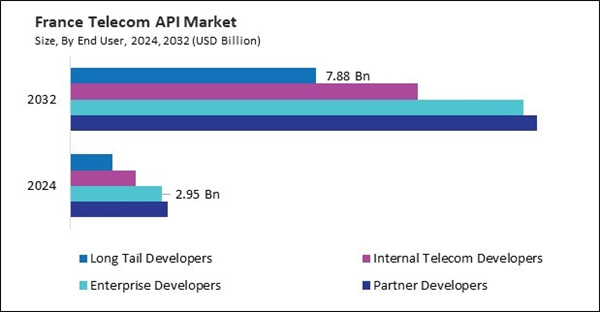The Germany market dominated the Europe Telecom API Market by country in 2024, and is expected to continue to be a dominant market till 2032; thereby, achieving a market value of $56.33 billion by 2032. The UK market is exhibiting a CAGR of 20.7% during 2025-2032. Additionally, the France market is expected to experience a CAGR of 22.7% during 2025-2032.
Telecom APIs find applications across a wide array of industries, enabling businesses to integrate communication functionalities into their platforms seamlessly. One of the most prominent applications is in the realm of messaging services. APIs for SMS, MMS, and OTT (Over-The-Top) messaging platforms like WhatsApp and RCS (Rich Communication Services) allow businesses to send notifications, alerts, and promotional messages directly to customers. For instance, e-commerce platforms use SMS APIs to send order confirmations and delivery updates, while financial institutions leverage them for two-factor authentication and fraud alerts. Voice APIs are another critical application, enabling businesses to embed voice-calling capabilities into applications.
Contact centers, for example, use voice APIs to facilitate customer support through automated call routing or interactive voice response (IVR) systems. Video APIs are also gaining traction, particularly in industries like healthcare, where telemedicine platforms rely on real-time video communication for remote consultations. Location-based APIs are widely used in logistics and ride-sharing apps, enabling real-time tracking of vehicles and optimizing delivery routes. Payment and billing APIs allow businesses to integrate telecom-based payment systems, such as mobile wallets or direct carrier billing, which are especially popular in regions with low credit card penetration.
Europe represents a mature yet dynamically evolving market in the Automotive Energy Recovery Systems (ERS) sector. As part of the global shift toward sustainable mobility and regulatory pressure to reduce emissions, the region has emerged as a leader in adopting ERS technologies such as regenerative braking, kinetic energy recovery systems (KERS), and exhaust heat recovery. Governmental policies from the European Union (EU), including strict CO₂ emission standards and incentives for energy-efficient vehicles, have significantly propelled the demand for ERS integration in both passenger and commercial vehicles. With a strong presence of automotive OEMs and technological innovators, Europe is uniquely positioned at the intersection of regulation-driven evolution and cutting-edge automotive engineering.
The European market has seen several key trends shaping the ERS landscape. Firstly, hybrid and electric vehicles (EVs) are gaining popularity, with ERS systems playing a critical role in enhancing energy efficiency and extending driving range. Regenerative braking systems, for example, have become standard in many hybrid and EV models. Secondly, there is a growing trend of lightweighting vehicles using advanced materials to complement ERS effectiveness, as reduced mass allows for more efficient energy capture and reuse. The European ERS market is highly competitive, with several established players dominating the scene. Major automotive manufacturers such as BMW, Mercedes-Benz, Renault, and Volkswagen are actively incorporating ERS in their hybrid and EV platforms.
Component suppliers like Bosch, Continental, and Valeo are also instrumental in the value chain, offering ERS modules such as electric turbochargers, brake energy recovery systems, and exhaust heat recovery units. The competition is not only based on cost and efficiency but also on innovation, system integration, and adaptability to different vehicle architectures. Startups and tech firms are also entering the fray, especially in software-based energy management solutions that optimize ERS performance. However, challenges such as high upfront costs, complexity in retrofitting legacy vehicle platforms, and limited awareness in lower-tier markets may hinder uniform adoption across all segments.
List of Key Companies Profiled
- Adobe, Inc.
- Avaya, Inc. (Avaya Holdings Corp.)
- Deutsche Telekom AG
- IBM Corporation
- Microsoft Corporation
- Amazon Web Services, Inc. (Amazon.com, Inc.)
- AT&T, Inc.
- Verizon Communications, Inc.
- Ericsson AB
- Twilio, Inc.
Market Report Segmentation
By End User
- Partner Developers
- Enterprise Developers
- Internal Telecom Developers
- Long Tail Developers
By Type
- Messaging API
- Web RTC API
- Payment API
- IVR API
- Location API
- Other Type
By Country
- Germany
- UK
- France
- Russia
- Spain
- Italy
- Rest of Europe
Table of Contents
Companies Mentioned
- Adobe, Inc.
- Avaya, Inc. (Avaya Holdings Corp.)
- Deutsche Telekom AG
- IBM Corporation
- Microsoft Corporation
- Amazon Web Services, Inc. (Amazon.com, Inc.)
- AT&T, Inc.
- Verizon Communications, Inc.
- Ericsson AB
- Twilio, Inc.









